History of the CQB Tool with 8 Modern Examples

Knife use in a personal defense situation is as basic as it gets—grab, stab, slash, repeat as necessary. There is a certain purity in simplicity. You don’t announce it. You keep it hidden and out of sight, striking hard and suddenly without warning. Karambit-style blades have been doing this for hundreds, if not thousands, of years.
The Karambit: What is It?
Originating in Southeast Asia— particularly Indonesia, Sumatra, Malaysia, and Java—karambits are patterned from animal claws and talons. The ability to penetrate and rip flesh apart serves as a blueprint for the karambit blade design.
Like kukris and machetes, karambits are dual-purpose blades and not solely a fighting implement. They are also a utility tool for harvesting rice and root crops and skinning animals. With the European colonization of Southeast Asia, the karambit made its way to neighboring countries like Cambodia, Laos, Myanmar, Thailand, and the Philippines.
Karambits are characterized by a C-shaped “claw” blade and a handle with a ringlet/safety ring on the end. The ringlet offers a place to insert the index or pinky finger, offering superior retention characteristics. In addition, the ring can also double as an impact device—think brass knuckle.
Undoubtedly, you have seen the flashy moves of expert martial artists using a karambit. The unorthodox nature of the karambit is one of its advantages. Punching, poking, stabbing, flailing, and slashing actions are all possible with this weapon. Trained users can quickly transition between these moves.
The ring offers the ability to “flip,” “twirl,” or “slap” the karambit at an opponent, cutting upon contact. Karambits are capable of additional moves not typical of the usual stabbing action associated with other knives. As a result, your opponent may have difficulty “reading” your moves and countering them.
Reading the Room
For most of us, it’s likely that the knife you will be carrying will be a small, legally permissible blade. However, it most likely has the added caveat of being a folder versus a fixed blade.
Walking down the street with a Bowie on your belt is not realistic. Hell, this was outlawed in most jurisdictions back in the 1800s, let alone being acceptable today.

However, a small blade is inefficient for targeting your attacker’s torso or neck to disable them via blood loss, shock, or damage to vital organs. The most efficient way to impede your attacker with a small blade is to stop the specific body parts that are dangerous to you.
This is accomplished by cutting the structures that instantly disable those body parts. Specifically, muscles, ligaments, tendons, and nerves. A knife that is designed to cut versus pierce is certainly an asset here.
Pressure cuts are emphasized for getting the most effectiveness out of your blade against specific structural targets. This is critical to achieving maximum effect when carrying legal-length folding knives rather than full-sized, fixed-blade fighting knives.
The karambit lends itself well to this role. With a karambit-style blade, one can dump power into the cut. This is regardless of whether you’re using the pinky finger in the ring, orientating the tip up, or in reverse grip with the index finger in the ring, orientating the tip down.
Pros and Cons of the Karambit
All weapons—blades or firearms—have pros and cons. The karambit is best at CQB work. With the karambit clenched tightly in the fist, up close and personal, it’s difficult to detect while ripping through tissue.
The karambit is designed to cut. With that said, the karambit is not made for thrusting, due to the geometry blade.
Over the years, my knife training has consisted of numerous sessions/seminars. This includes training with Michael Janich, Tom Sotis, Gabe Suarez, and others I do not have the space to list, or they prefer me not to.
The karambit is the quintessential small combat knife. While not discounting the benefits of formal martial arts training, the karambit is intuitive. No clever knife drills are needed. Just adrenalin-fueled aggression and violence.
No matter how strong you are, there will be someone stronger. Likewise, no matter how big you are, you will find someone bigger. The knife evens the odds. Attack fast, hard, and repeatedly.
Think tearing and ripping, not stabbing. Pain and rapid blood loss will serve as the vehicles of stopping power here.
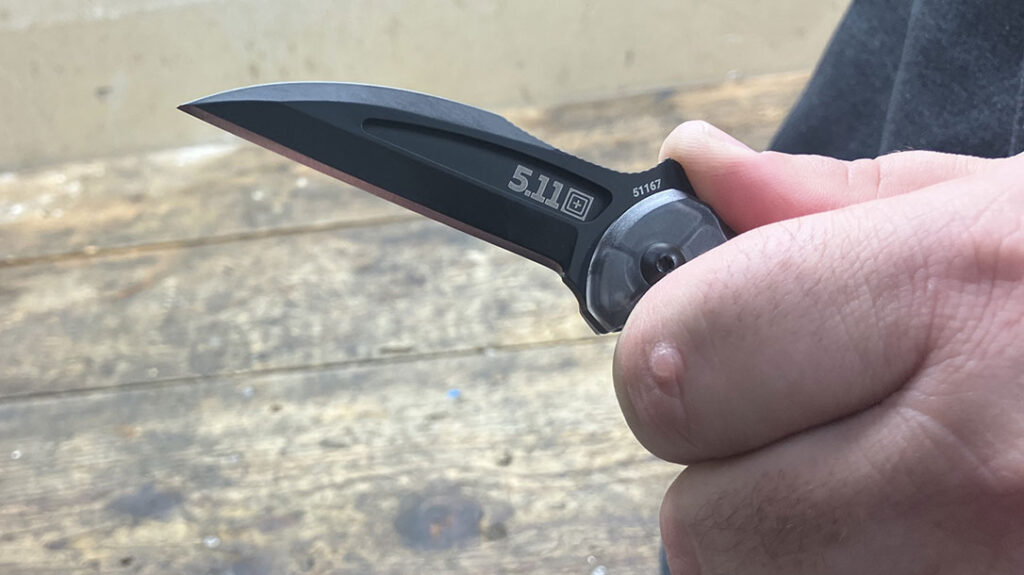
Karambit Options
Choosing a knife is probably an even more personal decision than a firearm. Some will question the veracity of the karambit, with its focus on slashing/cutting use. However, others will appreciate its simple, solid design methodology based on a thousand years of experience.
Lists are always problematic because you can’t include everything, and someone will always feel something important was left out. With that said, the goal of this article is to focus on multiple production karambit knives that best represent the karambit form. For this reason, custom karambits will not be part of our list. But I did select both fixed and folding karambit blades.
Obviously, fixed blade karambits are quicker and simpler to deploy. However, fixed blades are often harder to conceal effectively. Conversely, folders, while discrete, need to have a method of self-deploying to save time in opening.
Hopefully, this list will generate thought on what karambit knives you would include on your own list:
CRKT Provoke
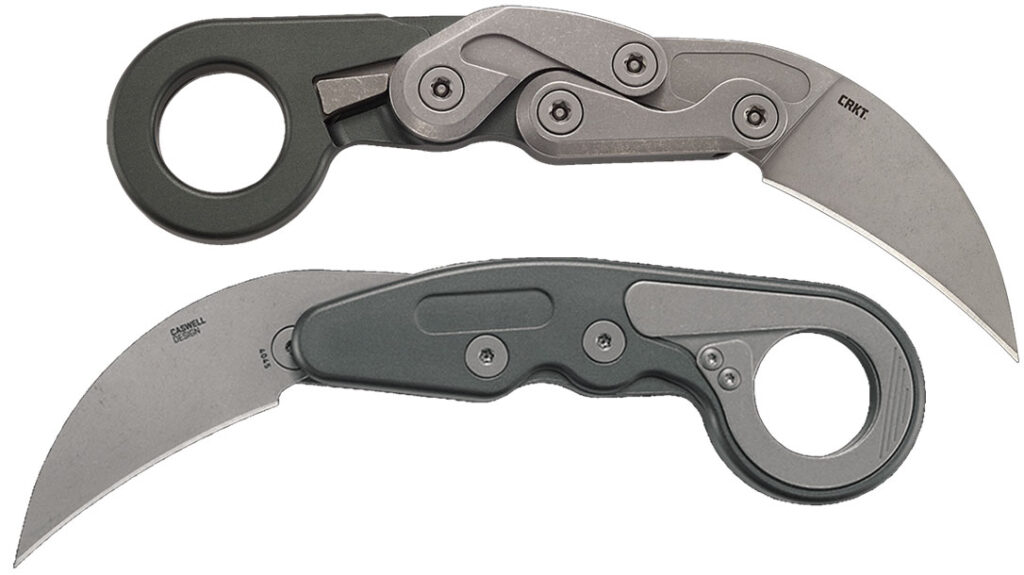
The CRKT Provoke is the blade that started me on the path to explore more about karambit-style blades. This is ironic, considering the Provoke is probably more renowned for its Kinematic technology method of opening. An ingenious “Rocker” mechanism opens the Provoke versus a single rotating point.
The literature suggests opening the Provoke with your thumb. However, it’s also easily made ready by catching the lip of the pocket as it is pulled out.
For more information, please visit CRKT.com.
Specs
| Blade Material | D2 |
| Handle Material | Aluminum |
| Overall Length | 7.25 inches |
| Closed Length | 4.96 inches |
| Blade Length | 2.41 inches |
| Weight | 6.10 ounces |
| MSRP | $200.00 |
5.11 Tactical Doug Marcaida Talon—Fixed
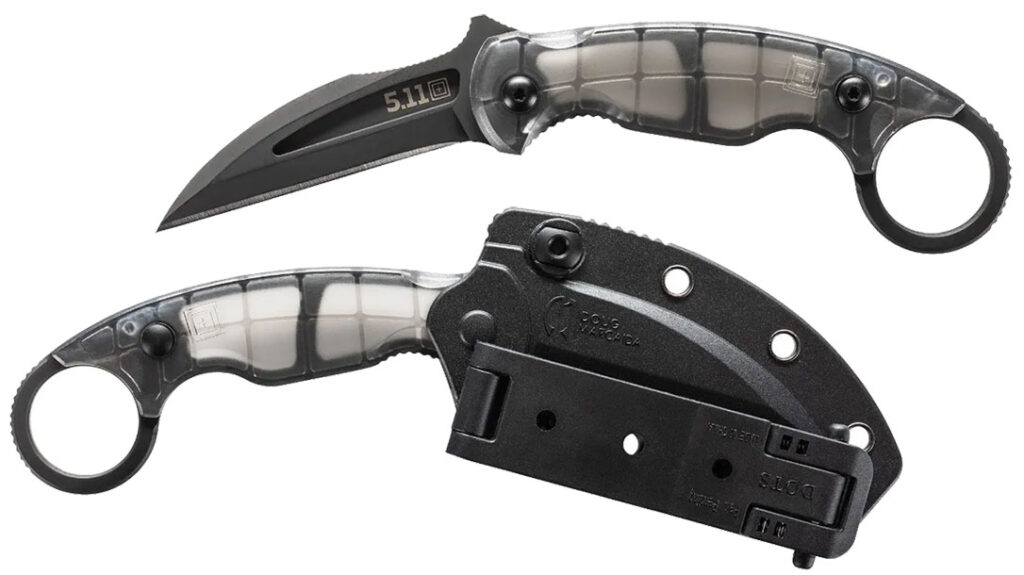
The 5.11 Tactical Talon quickly established itself as my most carried fixed-blade karambit variant. Size, weight, and a well-done sheath enabled discrete static line carry. The handle could be shielded from view, with the ring allowing easy deployment, even if stuffed inside the waistband. Additionally, the angle of the Talon blade is not as curved as most karambits, offering better penetration.
For more information, please visit 511Tactical.com.
Specs
| Blade Material | D2 |
| Handle Material | Translucent FRN |
| Overall Length | 7.10 inches |
| Blade Length | 1.70 inches |
| Weight | 3.5 ounces |
| MSRP | $95.00 |
Emerson Combat Karambit

No list of karambits would be complete without something from Emerson Knives. Inventor of the “Wave” opening system, Emerson Knives has been in the karambit game for many years. The company offers hard-use folding models like the Combat Karambit, as well as fixed-blade models. Likewise, Emerson Knives offers a karambit training DVD and training karambits to help get you up to speed.
For more information, please visit EmersonKnives.com.
Specs
| Blade Material | 154CM |
| Handle Material | G-10 |
| Overall Length | 6.8 inches |
| Blade Length | 2.6 inches |
| Weight | 4.5 ounces |
| MSRP | $285.95 |
Cold Steel Steel Tiger
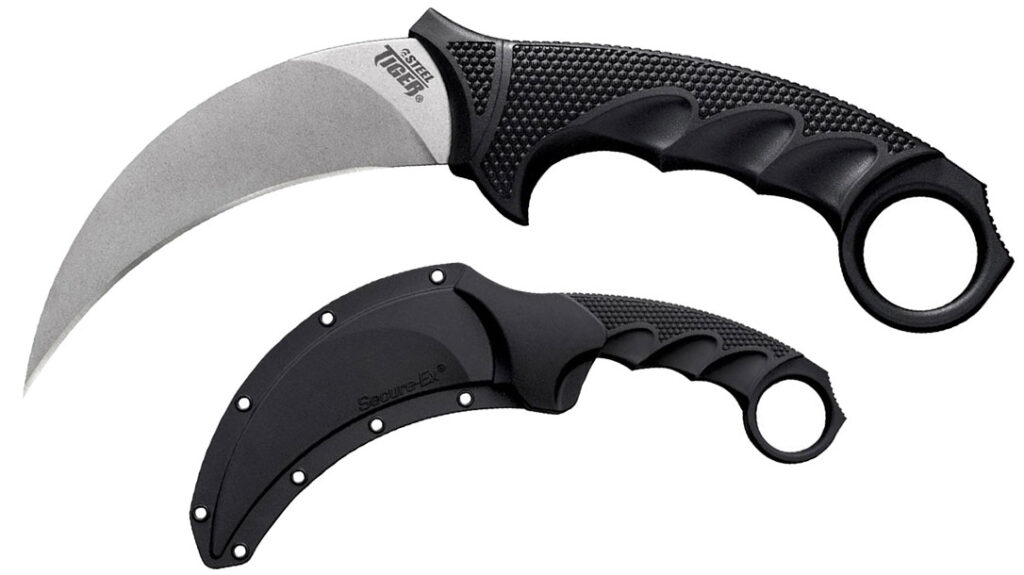
The Cold Steel Tiger is a great example of a fixed-blade Indonesian-style karambit, with its highly curved razor-sharp blade. One advantage of the Steel Tiger is that Cold Steel offers a training version as well.
For more information, please visit ColdSteel.com.
Specs
| Blade Material | AUS 8A stainless steel |
| Handle Material | Griv Ex over-molded with Kray Ex polymer |
| Overall Length | 8.75 inches |
| Blade Length | 4.75 inches |
| Weight | 5 ounces |
| MSRP | $69.00 |
CRKT Du Hoc
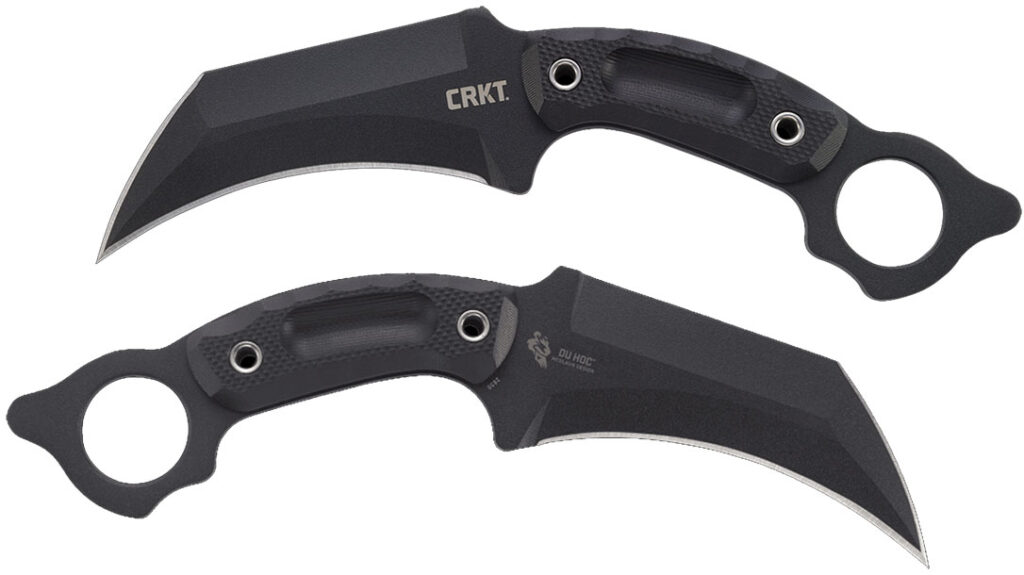
The Du Hoc is a fixed-blade monster of a karambit. It is a pure fighting knife affixed to your battle belt or plate carrier and is all business. Both inner and outer edges are extremely sharp. If you want to spill an opponent’s entrails, this is the knife to do it.
CRKT did just as good a job with the Du Hoc sheath. It has good retention and numerous points that can be used to lash to gear. Likewise, you can affix the Tec-Loc belt attachment that arrives with it as well.
For more information, please visit CRKT.com.
Specs
| Blade Material | SK-5 |
| Handle Material | G-10 |
| Overall Length | 9.63 inches |
| Blade Length | 5.1 inches |
| Weight | 9.3 ounces |
| MSRP | $120.00 |
Blackhawk! Blade Garra III
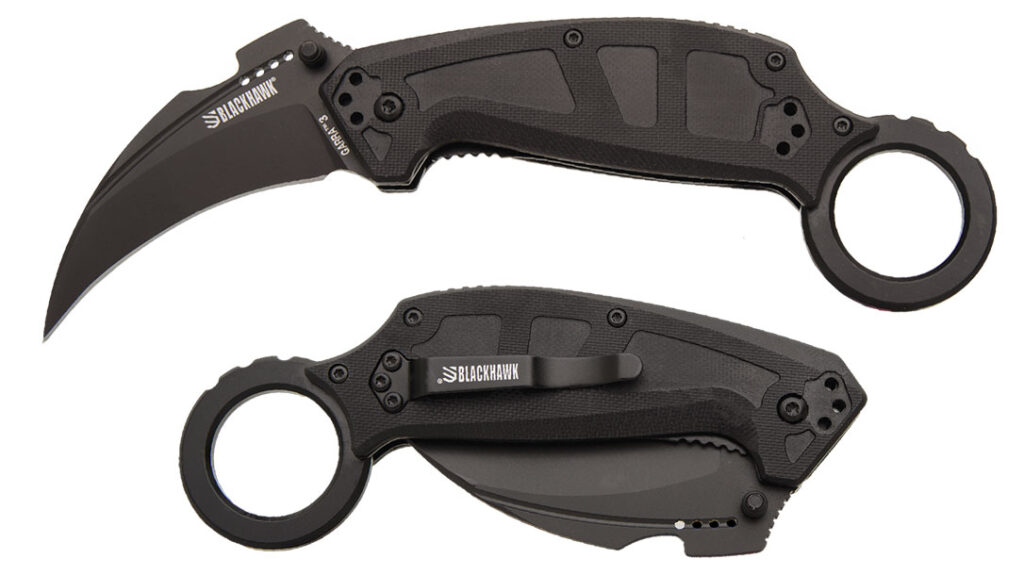
Offered via Bear & Son Cutlery, the Garra III folder features a thumb stud for opening. The Garra III arrives ready for right-hand tip-up carry but can be configured for right- or left-hand, tip-up, or tip-down.
The ringlet on the Garra III is very ergonomic in the hand, with either a forward or reverse grip. The word dainty could be used with Garra III if it was not so deadly. A raised thumb ramp offers additional leverage for pressure cutting.
For more information, please visit BearAndSonCutlery.com.
Specs
| Blade Material | D2 |
| Handle Material | G-10 |
| Overall Length | 7.5 inches |
| Closed Length | 5.25 inches |
| Blade Length | 2.25 inches |
| Weight | 5.1 ounces |
| MSRP | $119.00 |
Spyderco Karahawk Black Blade
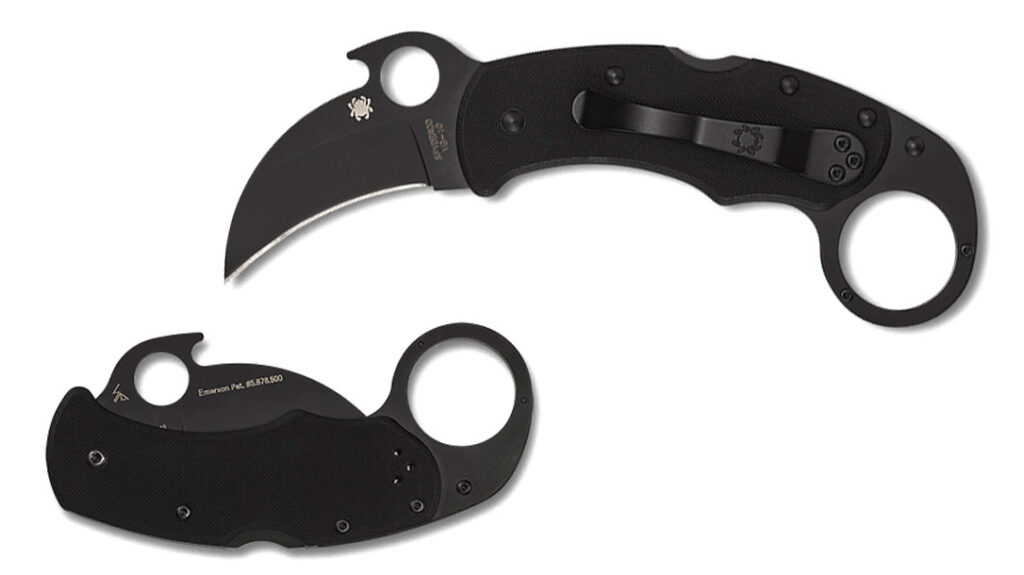
The Karahawk is a great example of Spyderco’s well-thought-out approach to the karambit. It improves a classic design with subtle tweaks while taking advantage of modern materials.
The Karahawk folder offers two opening methods—the Spyderco Round Hole built into the blade flat and the Emerson Wave. The Wave catches the knife on the pocket’s lip and pulls the knife open as it is being drawn. Both methods offer a means of rapid deployment in case of emergency.
For more information, please visit Spyderco.com.
Specs
| Blade Material | VG-10 |
| Handle Material | G-10 |
| Overall Length | 6.5 inches |
| Closed Length | 4.5 inches |
| Blade Length | 2.29 inches |
| Weight | 3.8 ounces |
| MSRP | $373.00 |
Cold Steel Tiger Claw

The Tiger Claw folder is a Cold Steel version of the karambit, using Andrew Demko’s karambit/hawkbill hybrid blade. Demko arrived at this design based on his needs as an electrician. However, do not mistake the Tiger Claw as a utility blade only. A patented Demko thumb plate serves as the opening method when pulled from the pocket.
For more information, please visit ColdSteel.com.
Specs
| Blade Material | American S35VN |
| Handle Material | G-10 |
| Overall Length | 9 inches |
| Closed Length | 6 inches |
| Blade Length | 3.5 inches |
| Weight | 5.1 ounces |
| MSRP | $199.00 |




Didn’t find what you were looking for?
Read the full article here


:quality(70)/cloudfront-us-east-1.images.arcpublishing.com/archetype/CNUH4CGV7RAGJHIKODNUWJ73OM.jpg)
:quality(70)/cloudfront-us-east-1.images.arcpublishing.com/archetype/7TMFHR4XGJEJNIE3N77YQHA5WM.jpg)
:quality(70)/cloudfront-us-east-1.images.arcpublishing.com/archetype/R5KPUKLKHZFEBL4OBD6ZCSLTZE.jpg)
:quality(70)/cloudfront-us-east-1.images.arcpublishing.com/archetype/IMDGTNQXKBCFNDKYEDBHSAALH4.jpg)

:quality(70)/cloudfront-us-east-1.images.arcpublishing.com/archetype/KH4R7JF6ZJDBZNJ7KFZZFSNNCY.jpg)